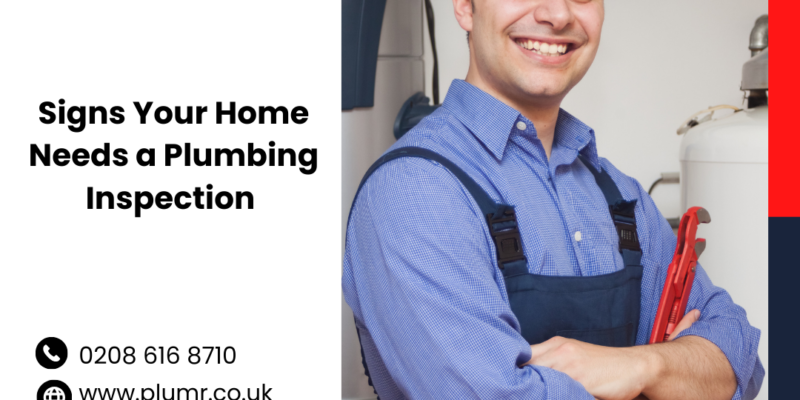
Introduction
Plumbing issues are often hidden from plain sight, lurking behind walls and under floors. These problems can escalate quickly, leading to significant damage and costly repairs. Regular plumbing service inspections are crucial to maintaining your home’s integrity and avoiding unexpected disasters. In this article, we’ll explore the key signs that indicate your home needs a plumbing inspection.
Unusual Water Bills
Unexpected Spikes
An unexpected increase in your water bill is one of the most telling signs that your home might have a plumbing issue. If your bill has suddenly spiked without any significant change in your water usage, it could indicate a leak somewhere in your plumbing service in South London. Even small leaks can waste a surprising amount of water, leading to higher bills.
Comparison
To detect anomalies, compare your past and present water bills. Look for patterns and any sudden increases. If there’s a noticeable spike without a corresponding increase in water usage, it’s time to investigate further and possibly call in a professional.
Water Pressure Issues
Low Water Pressure
Low water pressure can be more than just an inconvenience; it can be a sign of serious plumbing problems. Blockages, pipe corrosion, or leaks are common causes of low water pressure. If you notice a consistent drop in water pressure throughout your home, getting a plumbing inspection is essential to identify and fix the underlying issue.
High Water Pressure
Conversely, excessively high water pressure can strain your plumbing system, damaging pipes, leaks, and other issues. It can also cause pipes to burst and fixtures to fail. Installing a pressure regulator can help, but it’s also wise to have a plumber check for potential issues.
Discolored Water
Rusty or Brown Water
If your water has a rusty or brown tint, it could indicate pipe corrosion or the presence of sediment. It is widespread in older homes with galvanized steel pipes. Over time, these pipes can rust from the inside out, leading to discoloured water and potential health hazards.
Green or Blue Water
Green or blue-tinted water can be a sign of copper pipe corrosion. It occurs when copper pipes corrode, releasing copper into the water. While copper is an essential nutrient in small amounts, high levels can be harmful and indicate that your plumbing needs attention.
Slow Drains
Consistent Slow Drainage
Persistent slow drainage in sinks, tubs, or showers can indicate blockages in your plumbing system. While occasional slow drainage might be due to hair or soap buildup, consistent issues suggest more significant problems, such as more profound clogs in the pipes.
Multiple Slow Drains
If you notice multiple slow drains throughout your home, it could signal a more significant issue with the main sewer line. This problem requires immediate attention to prevent severe damage and ensure the proper functioning of your plumbing system.
Unpleasant Odors
Sewer Smells
The smell of sewage or gas inside your home is a serious issue that needs immediate attention. Sewer smells can indicate a broken sewer line, a venting problem, or other significant matters. Ignoring these smells can lead to health hazards and extensive property damage.
Moldy or Musty Smells
Musty odours often point to hidden leaks causing mould growth. Mould damages your home and poses health risks to you and your family. If you detect a mouldy smell, promptly locating and fixing the leak is essential.
Water Stains and Damage
Ceiling and Wall Stains
Water stains on ceilings or walls are clear indicators of plumbing system leaks. These stains often appear yellow or brown patches and signify leaks from pipes above or within the walls. Left unaddressed, these leaks can cause structural damage and mould growth.
Floor Damage
Warped or stained floors can signal leaks from pipes beneath the flooring. If you notice any unusual changes in your flooring, such as warping, staining, or a spongy feel, it’s essential to investigate further and address any leaks promptly.
Noisy Pipes
Banging or Clanking
Noises like banging or clanking in pipes, known as water hammer, can indicate issues such as loose pipes or pressure problems. If left unaddressed, a water hammer can cause significant damage to pipes and fixtures. Installing water hammer arrestors and securing loose pipes can help mitigate these issues.
Whistling or Humming
Whistling or humming noises can suggest high water pressure or pipe obstructions. These sounds are often caused by water moving too quickly through the pipes or partially closed valves. Addressing these issues can prevent further damage and ensure the smooth operation of your plumbing system.
Reduced Water Quality
Foul-Tasting Water
Water that tastes bad can indicate contamination or pipe corrosion. If you notice a metallic, bitter, or otherwise unusual taste in your water, it could be a sign of deteriorating pipes or contaminants entering your water supply. It’s crucial to have your water tested and your plumbing inspected to ensure safety and quality.
Cloudy Water
Cloudy or murky water can indicate sediment buildup or pipe issues. Sediment can accumulate in your water heater or pipes, affecting water clarity and quality. Regular flushing of your water heater and professional inspections can help maintain clear and safe water.
Conclusion
Regular plumbing inspections are essential for maintaining your home’s integrity and preventing costly repairs. By being aware of the signs that indicate a plumbing inspection is needed, you can take proactive steps to address issues early and avoid extensive damage. If you notice any of the signs discussed, don’t hesitate to schedule a professional plumbing inspection. The long-term benefits of regular plumbing maintenance and inspections far outweigh the costs, helping you preserve your home’s value and ensure a safe and comfortable living environment.
FAQs:
1. How often should I have my home’s plumbing inspected?
Answer: Ideally, you should have your plumbing inspected annually to catch issues early and maintain system health. Regular inspections help identify potential problems before they become significant, saving you time and money in the long run.
2. Can I perform a plumbing inspection myself?
Answer: While homeowners can perform some basic checks, such as looking for visible leaks or monitoring water pressure, a professional inspection is recommended for a thorough assessment. Professionals have the tools and expertise to identify hidden issues that might be missed during a DIY inspection.
3. What should I do if I notice any of these signs?
Answer: If you notice any signs such as unusual water bills, water pressure issues, discoloured water, slow drains, unpleasant odours, water stains, noisy pipes, or reduced water quality, contact a licensed plumber immediately. Prompt action can prevent minor issues from escalating into major problems.
4. How can I find a reliable plumber for inspections?
Answer: Look for licensed, insured, and well-reviewed plumbers in your area. Ask for recommendations from friends, family, or neighbours. Checking online reviews and ratings on platforms like Google, Yelp, or the Better Business Bureau can also help you find a trustworthy professional.
5. What are the risks of ignoring plumbing issues?
Answer: Ignoring plumbing issues can lead to severe damage to your home, including structural damage, mould growth, and water damage. Additionally, untreated plumbing problems can result in higher water bills, reduced water quality, and potentially hazardous living conditions.
6. How much does a professional plumbing inspection cost?
Answer: The cost of a professional plumbing inspection can vary depending on your location and the complexity of the inspection. Some plumbers may offer free inspections as part of a service package or promotional offer.
7. What does a professional plumbing inspection include?
Answer: A professional plumbing inspection typically includes checking for leaks, examining water pressure, inspecting pipes and fixtures, evaluating the condition of the water heater, checking for signs of corrosion or damage, and assessing the overall efficiency of your plumbing system.
8. Can plumbing issues affect my water quality?
Answer: Yes, plumbing issues such as pipe corrosion, leaks, and sediment buildup can negatively impact water quality. Contaminants can enter your water supply, leading to foul-tasting, discoloured, or cloudy water. Regular inspections help ensure your water remains clean and safe.
9. Are there preventative measures I can take to avoid plumbing issues?
Answer: Yes, regular maintenance such as flushing your water heater, avoiding pouring grease down drains, using drain covers to catch debris, and insulating pipes in colder months can help prevent plumbing issues. Additionally, scheduling annual professional inspections can identify potential problems early.
10. What should I do in case of a plumbing emergency?
Answer: In a plumbing emergency, such as a burst pipe or severe leak, turn off the main water supply immediately to prevent further damage. Contact a licensed plumber as soon as possible to address the issue. Having an emergency plumber’s contact information readily available can save time in a crisis.





